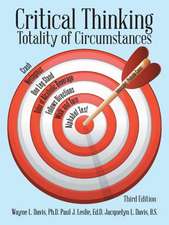Faculty Diversity: Removing the Barriers
Autor JoAnn Moodyen Limba Engleză Paperback – 19 dec 2011
This revised edition includes:
- New strategies to prevent unintended cognitive bias and errors that damage faculty recruitment and retention
- Expanded discussion on the importance of different cultural contexts, political, and historical experiences inhabited and inherited by non-immigrant faculty and students
- Increased testimonials and on-the-ground reflections from faculty, administrators, and leaders in higher education, with new attention to medical and other professional schools
- Updated Appendix with Discussion Scenarios and Practice Exercises useful to search and evaluation committees, department chairs, deans, faculty senates, and diversity councils
- Expanded chapter on mentoring that dispels myths about informal mentoring and underlines essential components for formal programs.
| Toate formatele și edițiile | Preț | Express |
|---|---|---|
| Paperback (1) | 406.23 lei 6-8 săpt. | |
| Taylor & Francis – 19 dec 2011 | 406.23 lei 6-8 săpt. | |
| Hardback (1) | 1058.19 lei 6-8 săpt. | |
| Taylor & Francis – 20 dec 2011 | 1058.19 lei 6-8 săpt. |
Preț: 406.23 lei
Nou
Puncte Express: 609
Preț estimativ în valută:
77.73€ • 81.16$ • 64.33£
77.73€ • 81.16$ • 64.33£
Carte tipărită la comandă
Livrare economică 04-18 aprilie
Preluare comenzi: 021 569.72.76
Specificații
ISBN-13: 9780415878463
ISBN-10: 0415878462
Pagini: 284
Dimensiuni: 152 x 229 x 18 mm
Greutate: 0.85 kg
Ediția:Revizuită
Editura: Taylor & Francis
Colecția Routledge
Locul publicării:Oxford, United Kingdom
ISBN-10: 0415878462
Pagini: 284
Dimensiuni: 152 x 229 x 18 mm
Greutate: 0.85 kg
Ediția:Revizuită
Editura: Taylor & Francis
Colecția Routledge
Locul publicării:Oxford, United Kingdom
Public țintă
Professional Practice & DevelopmentCuprins
Introduction
PART ONE: THE BARRIERS TO FACULTY DIVERSITY
Chapter 1: Cognitive Errors that Contaminate Academic Evaluations and Block Faculty Diversity
Chapter 2: Negative Bias and Positive Bias: Two Powerful Cognitive Errors that Impede the Advancement of Some Faculty and speed the Advancement of Others
Chapter 3: Disadvantages for Non-Immigrant Groups but Advantages for Immigrant and "Honorary White" Groups
PART TWO: REMOVING THE BARRIERS TO FACULTY DIVERSITY
Chapter 4: Faculty Recruitment: Replacing Dysfunctional Practices with Good Practices
Chapter 5: Faculty Retention: Replacing Dysfunctional Practices with Good Practices
Chapter 6: Faculty Mentoring: Replacing Dysfunctional Practices with Good Practices
Conclusion
Appendix A: A Colonized Group in Another Country: The Same Caste-Like Pattern
Appendix B: Imprisonment of African-American Men: A New Caste-System Invented in 1980
Appendix C: Caste Systems
Appendix D: Reproduction of Group Inequalities by Standardized and High-Stakes Testing
Appendix E: Discussion Scenarios—Practice Exercises
References
PART ONE: THE BARRIERS TO FACULTY DIVERSITY
Chapter 1: Cognitive Errors that Contaminate Academic Evaluations and Block Faculty Diversity
Chapter 2: Negative Bias and Positive Bias: Two Powerful Cognitive Errors that Impede the Advancement of Some Faculty and speed the Advancement of Others
Chapter 3: Disadvantages for Non-Immigrant Groups but Advantages for Immigrant and "Honorary White" Groups
PART TWO: REMOVING THE BARRIERS TO FACULTY DIVERSITY
Chapter 4: Faculty Recruitment: Replacing Dysfunctional Practices with Good Practices
Chapter 5: Faculty Retention: Replacing Dysfunctional Practices with Good Practices
Chapter 6: Faculty Mentoring: Replacing Dysfunctional Practices with Good Practices
Conclusion
Appendix A: A Colonized Group in Another Country: The Same Caste-Like Pattern
Appendix B: Imprisonment of African-American Men: A New Caste-System Invented in 1980
Appendix C: Caste Systems
Appendix D: Reproduction of Group Inequalities by Standardized and High-Stakes Testing
Appendix E: Discussion Scenarios—Practice Exercises
References
Recenzii
"Medical schools should pay close attention to this book, especially the discussion of how to remove cognitive errors that can contaminate personnel evaluations and thwart faculty diversity."
—Joseph Hopkins, M.D., Clinical Professor, Stanford School of Medicine and Director of Stanford Leadership Development Program.
"Legal counsel for higher education institutions—as well as diversity officers and faculty developers within law and other professional schools—will profit from using this engagingly written guide from an expert."
—Jonathan Alger, J.D., Senior Vice President and General Counsel, Rutgers University.
"This is a must read! The author’s truth-telling and practical advice are important for community colleges, research universities, and in fact any research lab or educational institution."
—Kyrsis Rodriguez, Ph.D., Professor of Science, Roxbury Community College.
"Dr. Moody’s depth of experience and use of up-to-date research are evident in every chapter. Highly recommended for liberal arts campuses, faculty reading circles, ‘difficult dialogues’ series, and presidents’ and provosts’ cabinets."
—Beverly Daniel Tatum, Ph.D., President, Spelman College and formerly Dean and Acting President at Mt. Holyoke College.
"Academic leaders including campus presidents, provosts, deans, department chairs, search and tenure/promotion committees, diversity councils, and chief diversity officers can greatly impact the diversification of faculty if they heed what Dr. Moody has to say."
—Jozi De Leon, Ph.D., Vice President for Equity and Inclusion, University of New Mexico.
—Joseph Hopkins, M.D., Clinical Professor, Stanford School of Medicine and Director of Stanford Leadership Development Program.
"Legal counsel for higher education institutions—as well as diversity officers and faculty developers within law and other professional schools—will profit from using this engagingly written guide from an expert."
—Jonathan Alger, J.D., Senior Vice President and General Counsel, Rutgers University.
"This is a must read! The author’s truth-telling and practical advice are important for community colleges, research universities, and in fact any research lab or educational institution."
—Kyrsis Rodriguez, Ph.D., Professor of Science, Roxbury Community College.
"Dr. Moody’s depth of experience and use of up-to-date research are evident in every chapter. Highly recommended for liberal arts campuses, faculty reading circles, ‘difficult dialogues’ series, and presidents’ and provosts’ cabinets."
—Beverly Daniel Tatum, Ph.D., President, Spelman College and formerly Dean and Acting President at Mt. Holyoke College.
"Academic leaders including campus presidents, provosts, deans, department chairs, search and tenure/promotion committees, diversity councils, and chief diversity officers can greatly impact the diversification of faculty if they heed what Dr. Moody has to say."
—Jozi De Leon, Ph.D., Vice President for Equity and Inclusion, University of New Mexico.
Descriere
Why do we see so little progress in diversifying faculty at America’s colleges, universities, and professional schools? This handbook answers that question and provides steps for hastening faculty diversity.



















